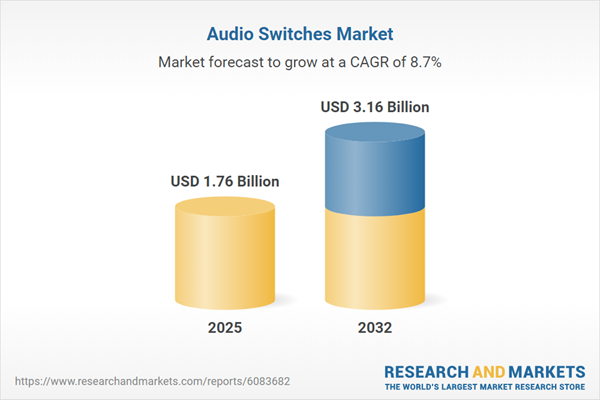Speak directly to the analyst to clarify any post sales queries you may have.
The audio switches market is undergoing rapid transformation, shaped by shifts in technology, adoption patterns, and increasing demands for innovation across sectors like consumer electronics, automotive, and industrial automation. Senior decision-makers require an integrated view to navigate this evolving environment and capitalize on emerging opportunities.
Market Snapshot: Audio Switches Market Size and Growth
The audio switches market grew from USD 1.63 billion in 2024 to USD 1.76 billion in 2025. With a projected CAGR of 8.65%, market value is expected to reach USD 3.16 billion by 2032. This expansion is driven by sustained investments in advanced electronics, increased use of intelligent switching in automotive systems, and rising demand for seamless signal integration across devices. Companies are shifting focus towards hybrid, optical, and digital solutions to address emerging requirements in miniaturization, channel density, and environmental compliance.
Scope & Segmentation
- Type: Hybrid switches, mechanical switches (clicky, linear, tactile), membrane switches, optical switches
- Actuation Force: Heavy actuation, light actuation, medium actuation
- Technology: Analog (active, passive), digital
- Technology Type: Capacitive switches, mechanical switches, membrane switches, optical switches
- Material Type: Ceramic, metal, plastic
- Switch Design: Push button switches, rocker switches, rotary switches, toggle switches
- Connectivity: Wired, wireless (Bluetooth, NFC, Wi-Fi)
- Channel Distribution: Direct sales, distributors, e-commerce, retail
- Application Type: Automotive controls, communication devices, consumer electronics, industrial equipment, medical instruments
- Regional Coverage: Americas (United States, Canada, Mexico, Brazil, Argentina, Chile, Colombia, Peru), Europe, Middle East & Africa (United Kingdom, Germany, France, Russia, Italy, Spain, Netherlands, Sweden, Poland, Switzerland, United Arab Emirates, Saudi Arabia, Qatar, Turkey, Israel, South Africa, Nigeria, Egypt, Kenya), Asia-Pacific (China, India, Japan, Australia, South Korea, Indonesia, Thailand, Malaysia, Singapore, Taiwan)
- Company Coverage: AMS AG, Analog Devices, Inc., Broadcom Inc., Cirrus Logic Inc., Cypress Semiconductor Corporation, Diodes Incorporated, Infineon Technologies AG, Linear Technology Corporation, Marvell Technology Group Ltd., Maxim Integrated Products, Inc., Microchip Technology Incorporated, NXP Semiconductors N.V., ON Semiconductor Corporation, Qualcomm Technologies, Inc., Renesas Electronics Corporation, Rohm Semiconductor, Skyworks Solutions, Inc., STMicroelectronics N.V., Texas Instruments Incorporated, Toshiba Electronic Devices & Storage Corporation
Key Takeaways: Strategic Insights for Audio Switches Market Stakeholders
- The migration from mechanical toggles to hybrid, optical, and capacitive switches is accelerating, driven by requirements for greater reliability, lower latency, and energy efficiency.
- Advanced digital signal processing and microelectromechanical systems are enabling more adaptive, compact, and integrated products suited to next-generation devices.
- Sustainability pressures, such as the adoption of lead-free materials and recyclable polymers, are compelling manufacturers to rethink processes and supplier relationships.
- Emerging opportunities are linked to modular design platforms, which allow manufacturers to respond quickly to niche end-user needs and evolving digital connectivity standards.
- Company strategies now emphasize cross-disciplinary innovation—combining photonic integration, AI-driven signal management, and software alliances for firmware enhancements.
- Regional differentiation is essential: manufacturers should align product roadmaps with local regulatory, channel, and technology landscapes across Americas, EMEA, and Asia-Pacific.
Tariff Impact: Navigating US Measures and Supply Chain Shifts
New United States tariff measures set for 2025 are poised to reshape global sourcing and cost structures for audio switch components. Companies are adopting dual-sourcing models, realigning supplier portfolios towards Southeast Asia and Latin America, and building vertical integration to buffer against lead-time volatility. Working closely with logistics partners and deploying just-in-time strategies is helping maintain supply continuity despite evolving trade conditions.
Methodology & Data Sources
This study combines extensive secondary research—drawing from whitepapers, technical bodies, trade journals, and regulatory filings—with in-depth primary interviews conducted with C-level executives, engineers, and procurement leaders. Rigorous data triangulation, expert-panel validation, and cross-tabulation analysis were employed to ensure accuracy and actionable insights throughout the market research process.
Why This Report Matters
- Delivers a comprehensive view of the competitive, technological, and regional dynamics shaping audio switches innovation and investment.
- Equips senior leaders with actionable intelligence to inform product, sourcing, and partnership decisions in a complex regulatory and supply chain landscape.
Conclusion
The audio switches market is moving toward greater integration, sustainability, and regional sophistication. Organizations leveraging these insights will be better positioned to align strategy, enhance resilience, and drive competitive advantage as the market continues its evolution.
Table of Contents
3. Executive Summary
4. Market Overview
7. Cumulative Impact of Artificial Intelligence 2025
Companies Mentioned
The companies profiled in this Audio Switches market report include:- AMS AG
- Analog Devices, Inc.
- Broadcom Inc.
- Cirrus Logic Inc.
- Cypress Semiconductor Corporation
- Diodes Incorporated
- Infineon Technologies AG
- Linear Technology Corporation
- Marvell Technology Group Ltd.
- Maxim Integrated Products, Inc.
- Microchip Technology Incorporated
- NXP Semiconductors N.V.
- ON Semiconductor Corporation
- Qualcomm Technologies, Inc.
- Renesas Electronics Corporation
- Rohm Semiconductor
- Skyworks Solutions, Inc.
- STMicroelectronics N.V.
- Texas Instruments Incorporated
- Toshiba Electronic Devices & Storage Corporation
Table Information
| Report Attribute | Details |
|---|---|
| No. of Pages | 193 |
| Published | November 2025 |
| Forecast Period | 2025 - 2032 |
| Estimated Market Value ( USD | $ 1.76 Billion |
| Forecasted Market Value ( USD | $ 3.16 Billion |
| Compound Annual Growth Rate | 8.6% |
| Regions Covered | Global |
| No. of Companies Mentioned | 21 |








